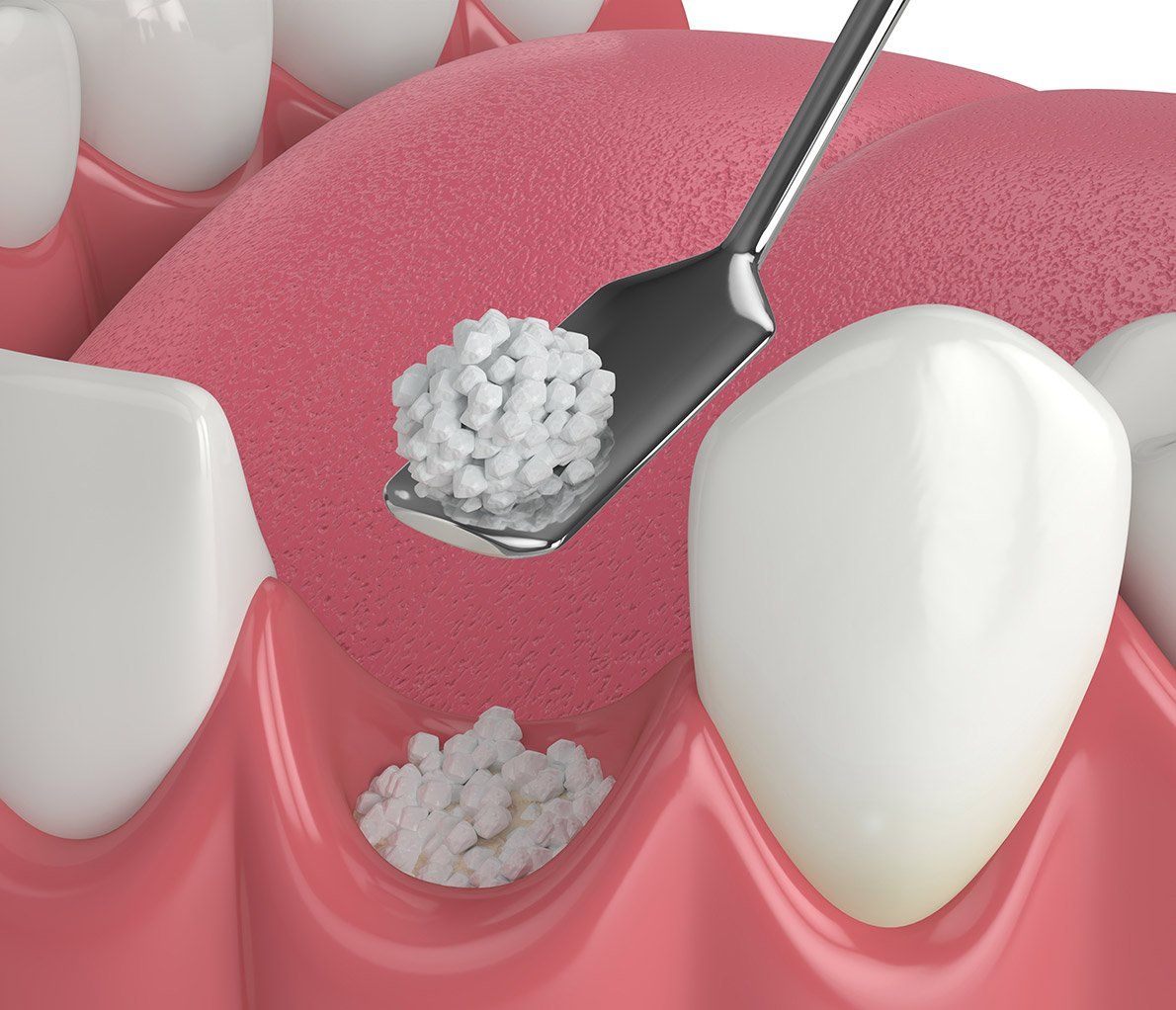Bone Grafting in Owings Mills, MD
Bone Grafting in Owings Mills, MD
You’re sitting in a dental office chair when your dentist advises you that you need a bone graft before a restorative procedure such as dental implants can be performed. You are immediately flooded with questions. What exactly is a dental bone graft? Why does it need to be done? What can I expect during the surgery and afterward?
What Is a Dental Bone Graft?
A dental bone graft should boost your body’s ability to make up missing bone tissue or to strengthen it. Once your dentist performs this procedure, your jawbone should have the strength needed to successfully accept dental implants.
Such grafts can help your bone become stronger by regrowing tissue. As the growth in the surrounding bone occurs, it absorbs the grafted material. In this way, the new bone tissue becomes completely united with the existing bone.

Dentists use various materials to add density to the bone or replace bone missing from your jaw. You and your dentist will choose one or more of the following materials for the grafting process:
- Natural bone. This type is made from bones that come from another person, usually a cadaver.
- Synthetic material. This type is based on a naturally occurring mineral found in healthy bones. It may also contain proteins that encourage your bones to develop.
- Bone from your own body. This bone most frequently comes from the chin, hip, or shin. This is often the preferred bone-grafting option because your body does not have to adapt to something that comes from outside yourself. It can also heal faster than grafts made from other materials.
- Ceramic-based grafts. This type is made from ceramics or combined with another substance like calcium or bioactive glass. When bioactive glass is applied to bone tissue, it forms the same mineral it touches.
- Animal bones. These most frequently come from cows or pigs.
Why Bone Loss May Occur in Your Mouth
There are several causes of jawbone loss including:
- Having a tooth removed
- Losing a tooth due to injury
- Cysts or tumors
- Gum disease
- Infections or systemic disease
- Naturally occurring events like aging or genetic defects
As a result of these causes, the surrounding jawbone that held the lost tooth or teeth can erode, especially if the missing teeth are not replaced with dental implants. Strong and vigorous chewing stimulates the jawbone beneath a natural tooth. When a tooth has been lost, the area no longer benefits from bone stimulation.
Once the bone stops receiving stimulation, it will experience a loss in density and mass, although it may take a few years for this to occur.
Types of Dental Bone Graft Procedures
There are several types of grafts used; the choice is made according to the reason the procedure is being done. Each type of graft is described below.
When You Should Consider a Dental Bone Graft
When a patient has lost dental bone mass, a bone graft may be used to maintain existing teeth or to provide support for an upcoming procedure such as dental implants. Such implants are made from screws and hold the artificial crown in place.
It is estimated that nearly half of all implant procedures will first require a bone graft. But even if no implant is planned, bone grafting may be used to build up a section of your jaw that may have deteriorated after losing a tooth.
It is important to address bone loss as soon as possible because it can affect not only the area itself but also surrounding teeth and gums.
But even if there are no missing teeth or dental implants planned, bone grafts can be used for patients whose facial appearance has changed due to bone loss from other causes. Such changes may lead to a face seeming to be shorter than before the loss occurred.
Sometimes loss to the lower jawbone can cause the skin around the jaw to appear wrinkled, resulting in the looks of your lips and surrounding area being altered.
What to Expect Before and During a Dental Bone Graft Surgery
Before performing your dental bone graft, Dr. Silverman will take x-rays to measure your bone density and health and to see if you may benefit from the graft. He will meet with you to consider your treatment and the best bone replacement material for your situation. Once that has been established, you are ready to receive the graft, which is performed as an outpatient procedure.
The bone graft proceeds in several steps:
- An anesthetic will be applied to the surgical area.
- The entire area will be cleaned by a dental technician.
- If a bone from your own body is to be used, the dentist will next take material from its source. If a tooth needs to be removed, the extraction will happen during this step.
- Now is the time for the graft material to be inserted. First, the dentist will meticulously clean the entire area. Next, if no tooth extraction is to be performed, an incision will be made in your gum so that the bone can be reached. Once the existing bone has been cut, the bone graft material will be attached to both sides.
- Next the incision will be closed.
- You may have gauze packed around the surgical site. If so, you may be instructed to change the gauze throughout the day of and following the bone graft. You may also receive an antibiotic so that the surgical area does not become infected. Pain medication may also be prescribed.
Recovery Process
Now it’s time to recover and heal from the process. Your dentist will instruct you in the care of the area. Follow these instructions carefully or the entire procedure may fail. Healing can take four months or longer and must take place before you can receive dental implants.
You may need to apply ice packs to reduce pain and swelling for the first day or two. You should plan on eating soft, mild food for a few days. Try not to consume hot drinks such as coffee or tea. You should refrain from eating anything crunchy like chips or nuts. And don’t engage in activities like contact sports that can cause injury to the incision site. Sleep with your head raised slightly to keep blood from accumulating around the surgical site.
You will be scheduled for a few visits with Dr. Silverman and possible X-rays to ensure that the site is healing as it should.
Is a Dental Bone Graft Painful?
If your procedure uses material other than bone taken from your own body, it is considered to be fairly minor. Since you will be given a sedative before the grafting process begins, no pain should occur until after the anesthesia wears off. Once it has worn off, you can usually manage your pain with over-the-counter medications such as acetaminophen. If over-the-counter medications do not help, call Dr. Silverman so he can prescribe prescription pain relievers.
Expect minor bleeding and some discomfort when eating and talking for a few days. To help with the discomfort, be sure to limit your eating to soft foods for the first few days. If swelling occurs, use ice packs on the surgery site. Ice cream lovers, take note: you may find relief from eating cold foods such as ice cream or drinking cold fluids.
When the bone to be used as the replacement comes from your own body, pain management may be necessary because you will have two areas where surgery occurred: both from the site where the bone was taken as well as the area around the surgical site in your mouth. It is important to note, however, that the portion of bone taken from its original location is actually quite small. This should limit the recovery time.
Preparations to Make Before a Bone Graft Procedure
There are not many actions that you can or should do before going in for your procedure. Your dentist may instruct you to:
- Give the dental office a list of all the medications you take.
- Refrain from eating or drinking 8 to 12 hours before the surgery.
- Have someone available to drive you home afterward because you may be unable to drive after the procedure is performed.
After the Procedure: When to Call Your Dentist
Surgeries involving dental bone grafts are normally straightforward and successful. The surgery is quite common and is usually safe and well-tolerated, although as with any surgery, there can be associated side effects. Follow your dentist’s advice and you will be more likely to have a successful recovery and better dental health following the procedure.
However, you should contact your dentist if:
- Your pain continues or worsens several days afterward
- You see redness or swelling in or around your gums
- You experience continued tingling or numbness
- You have received an implant and it becomes loose
Of course, there are many reasons to see your dentist. Believe it or not, bad oral health has been identified as a factor leading to the development of diabetes, cancer and heart disease.
You will be sure to benefit from a visit to your dentist for many reasons, from receiving regularly scheduled check-ups to the development of symptoms in and around your mouth to procedures such as receiving bone grafts. Symptoms that should have you calling for a dental appointment include mouth sores, sensitive teeth, gums that hurt or bleed, popping or clicking of your jaw, dry mouth, a broken or cracked tooth, and pain or swelling in your face, mouth or neck. Your dentist can also treat stained or discolored teeth.
Making and keeping dental appointments will increase your opportunity for good dental and overall physical health now and in the future.
If you need or are considering dental bone grafts or other dental work, schedule a visit with Dr. Silverman at The Maryland Center for Complete Dentistry in Owings Mills, MD 21117. Call us at (410) 356-8400.




